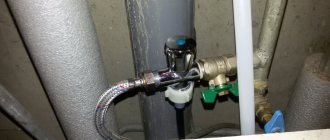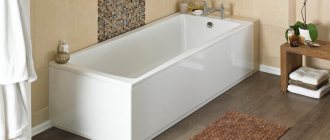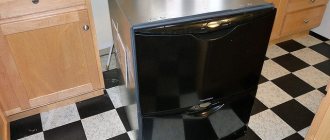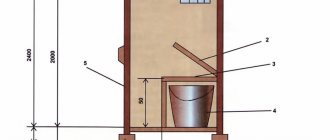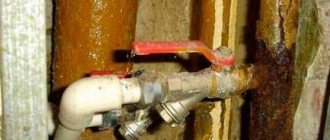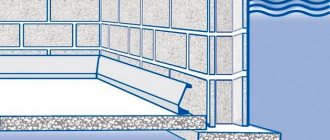The proper operation of the washing machine largely depends on how well the installation is done. An incorrectly chosen location or connection in violation of the instructions can lead not only to equipment breakdown, but also to electric shock to household members, which is much more serious. In terms of operation, the most suitable room for a washing machine is the bathroom, although high humidity and the size of the room make adjustments during installation.
Installing a washing machine in the bathroom
Site selection and equipment
Before you go to the store to choose a washing machine, think about where you will place it. Measure the depth, width and height of the selected location, adding at least 1 cm on all sides (correction for uneven walls). Agree, the situation when the equipment is physically unable to stand on the prepared area cannot be called pleasant.
The most common options for the location of automatic machines are:
- Bathroom
It is convenient because most of the communications are nearby. In addition, the device fits harmoniously into the surrounding space. To save space, the machine can be installed under the sink. Then you will have to choose a special form of plumbing with a drain in the back.
However, experts do not recommend placing the machine in the bathroom if there is an alternative, since in conditions of high humidity the parts wear out much faster and rust appears.
- Kitchen
Also, all connection nodes are located nearby, there is no need to re-equip anything additional. If you think through the design of the headset in advance, you can install a built-in washing machine or hide it behind one of the cabinet doors.
There are disadvantages here: increased humidity and temperature effects from the stove and oven. Therefore, it is recommended to install the device away from heating devices.
- Toilet
Some originals manage to install the unit even in a small toilet. In this case, the machine is located above the toilet.
This option requires special preparation and thoughtfulness: you need to be confident in the strength of the walls, install a reliable podium, and provide a vibration damper.
- Corridor
The location in the hallway is more common in desperate situations, when there is simply nowhere else to put the equipment.
The location has few positive features: communications have to be delayed, equipment takes up a lot of space, noise can be heard in all rooms.
- Lumber room
If you have a storage closet in your home, you can try converting it into a laundry room. This way, the washing machine will not interfere with anyone, and will be preserved better.
Some houses have special rooms that are designed for washing. If you are the lucky owner of such an apartment, well, congratulations, you are lucky.
- Basement
Such placement is possible in a private house, provided that the basement is heated and has electricity, water and sewerage installed.
If all requirements are met, this arrangement is very advantageous: the unit is not exposed to moisture, and its operation is inaudible for residents.
When the choice in favor of a certain room is made, you should think about the surface on which the machine will be located. The floor in this place should be hard and level.
Small differences in height can be corrected with the help of screw-in machine legs or a rubber mat, but they cannot compensate for strong unevenness. Therefore, if the installation is carried out on a wooden or uneven floor, then it makes sense to think about filling the area under the device with a concrete screed or installing a pallet.
Getting to know the instructions
Before you start working with the automatic machine, read the instructions! It contains a lot of useful information: what kind of outlet should there be, how to connect the drain and water supply, how to adjust the position of the unit, what malfunctions occur most often and whether you can fix them yourself, and much more.
Reading technical documentation is a separate step, since rarely does anyone turn to the manufacturer's prompts before a problem arises. This is usually only done if something doesn't go according to plan. You shouldn't do that.
The instructions provide detailed recommendations regarding the model of your washing machine, compliance with which will prevent many troubles. Do not ignore the manufacturer's advice: in the event of a breakdown, failure to follow them may result in your case being considered non-warranty.
Connecting an automatic washing machine to the water supply with your own hands
This stage is the most important and difficult. Therefore, you need to look at a few important points.
- Assess the place where the machine will stand. The connection method and the selection of the necessary parts will depend on this.
- It must be remembered that water hoses should be located behind furniture or interior parts. Their length will depend on this.
- It is necessary to estimate in advance the approximate length of the water hose. Very often the kit comes with very short ones.
- To connect to the water supply system you will need: pipes, a valve or a regular tap.
Faucet for connecting an automatic washing machine
The most common connection method is to connect it to a flat section of the water supply. To do this you will need a tee. Or this can be done on a special branch of the pipe. The connection to the tee or branch is made through the toilet cistern.
Preparation of communications
The washing machine is connected to three systems: sewerage, water supply and electricity.
Sewerage
There are several varieties possible here:
- Siphon under the sink - you need to install a splitter to the drain running under the sink. It will provide an outlet for the washing machine hose.
- Directly to the sewer - in this case, you will have to make a special outlet in the pipes or attach a tee when approaching the sink or bathtub.
- In the toilet or sink - the simplest and most unreliable option. Using a hook, the hose is hung on the plumbing fixtures, and the water flows out freely after washing.
Water supply
Most often, the machine is connected to cold water, and the device itself, using heating elements, heats it to the required temperature. However, some models provide connection to both cold and hot water.
This reduces electricity consumption, but increases the cost of hot water supply. In addition, such water often contains impurities and rust, which can lead to damage. And the units are more expensive. Therefore, the most common option remains connecting to cold water.
It is quite simple to install an additional outlet for water on polypropylene, metal-plastic and plastic pipes. A tee with one transition to metal should be installed. If there is a free outlet on the water supply pipes, great, the task is greatly simplified! All that remains is to install a shut-off valve.
You can install the simplest ball one. At the same time, do not forget to apply sealant and flax tow. There is an alternative option: a tee with a built-in tap. They are designed specifically for washing and dishwashing appliances. It is more convenient to install such a part, but if one of the parts fails, you will have to change the entire element, and they cost a lot.
Electricity supply
For correct and safe operation, the machine is connected to a separate grounded outlet. Please be aware that if there is no grounding, the manufacturer's warranty on the unit will no longer apply.
It must be located in close proximity to the device, since connecting extension cords or straining the wire is not allowed.
If there is no outlet that meets the stated requirements, contact an electrician. It will extend a separate power supply line from the panel with the required current parameters.
Do not attempt to install the outlet yourself unless you are properly qualified!
Model overview
Daewoo equipment is considered the most famous and affordable in this market segment. The Daewoo DWD-CV701PC washing machine model became the first wall-mounted unit put into mass production. It was originally conceived as an addition to a standard washing machine.
A wall-mounted machine can serve as a convenient addition to a full-sized unit
The declared characteristics allow the model to be used as a main washing machine for 1-2 people or as an additional one for a large family (for example, in order not to run a full-sized appliance for washing several things). Main features of the device:
- The front-loading machine has a hatch with a diameter of 26 cm and can hold up to 3 kg of dry laundry. The surface of the drum is made in the shape of a honeycomb, which helps to gently clean clothes from dirt.
- The maximum spin speed is 700 rpm (Class C), which is enough to get damp but not wet items out at the end of the cycle.
- The unit has 6 washing programs designed for main types of fabrics. Among them there are “Cotton”, “Delicate Wash”, “Children’s Clothes” modes.
- Washing class B allows you to wash lightly soiled clothes. The machine is ideal for rinsing items after a single use.
- The longest wash takes no more than 30 minutes. During this time, the unit is capable of washing 3 kg of laundry. Compared to a full-sized device, electricity consumption is 85-90% less, and water consumption is 80% less.
- The machine has three temperature modes: washing in cold water, at +40 ℃ or at +60 ℃.
- The household appliance weighs 17 kg, which is the minimum among all machines. Product dimensions – 55 x 29 x 60 cm.
The textured, honeycomb-shaped drum surface improves the quality of delicate washes.
A small compartment for washing powder guarantees significant savings in detergent. For ease of operation, the machine has an electronic display with large numbers and symbols. The equipment is equipped with protection against child intervention, but attached at the height of an adult, it already becomes inaccessible to the child.
The washing machine has a very small detergent compartment
Silent operation is ensured by an inverter motor. Sound insulation is also provided - a four-layer lining with an anti-vibration effect. The machine impresses with its quiet operation not only during washing and spinning, but also when drawing and draining water.
The control panel of the Daewoo wall-mounted model is clear to any user
Disadvantages include poor washing quality (compared to standard models), small load volume, weak spin and, of course, high cost.
The wall-mounted washing machine from Electrolux is also amazing. A smooth polished surface, an LED circle that glows during washing, a minimalist design - all this makes the equipment a decoration for any interior.
The wall-mounted unit from Electrolux looks modern and stylish
Connection and installation
Now all that remains is to free the unit from the packaging, remove the foam protection and unscrew the shipping bolts that are located on the back of the case.
They are designed to protect the internal parts of the device from damage during transport. Place plastic plugs (included in the kit) into the resulting holes.
Do not throw away shipping fasteners. They will come in handy when you move or need to take the device to service.
The corrugated drain hose into the sewer (usually included in the kit) must be installed in the siphon outlet and secured with a clamp. If the connection is made directly to the sewer pipe, then a rubber cuff is used as an adapter.
With any connection method, it is necessary to ensure that there are no kinks or strong kinks in the hose. But a bend at 60 cm from the floor is a common requirement. This is necessary to form a natural water seal - so that water and odors from the sewer do not penetrate into the device. A plastic clamp is used for fixation.
This rule is true for devices in which the drain hose is located at the bottom of the housing; if it comes out from the top, then the bend has already been made in the inside of the device. There are also now units with a check valve, for which you do not have to create additional “elbows”. This point should be clarified in the equipment documentation.
To connect to the water supply, we use a hose that is sold with the device. The side with the curved end should be connected to the machine: install the mesh filter (included in the kit) with the convex side towards the outlet and manually screw it on. The other end is also screwed onto the water supply tap by hand. There is no need to tighten too much, since there is a rubber seal at the joints that ensures tightness.
To make it even clearer, take a look at how this process goes in the video.
Preparatory work
A new washing machine needs to be unpacked - sometimes this takes almost as much time as installing the unit.
Unpacking your washing machine can take a long time
Then you need to be sure to study the instructions, which schematically show the installation locations of the transportation bolts. Keep in mind that for each model of household appliance, the number of such parts and their location may vary. Even experienced craftsmen in such matters always follow the recommendations of the washing machine manufacturer.
Shipping bolts are installed to ensure that moving parts of the equipment are not damaged during transportation. In addition to them, temporary valves in hoses or pieces of foam inserted into the body can be placed in the machine. Before putting the washing machine into operation, all these elements must be removed, otherwise the unit may break.
Often, household appliances come with a key for removing bolts, and special plastic plugs are used to close the resulting holes.
The transport bolts are unscrewed with a special wrench included with the washing machine.
Only after completely unpacking the washing machine can you begin to connect it.
Alignment
To prevent the washing machine from jumping, it is necessary to adjust its position - it must stand level. If this is not done, the internal components will quickly fail and the washing machine will have to be repaired.
To carry out the procedure, a building level is used, which is laid along each side. If there is a tilt somewhere, then you need to tighten the legs until the horizon line is perfect.
When this condition is met, try to slightly rock the machine: if it wobbles, then the adjustment should be continued.
Do not place pieces of wood, cardboard or linoleum under the legs! The device will still “move off” them.
Also, the floor should not be slippery. If the device is installed on tiles, you should lay a rubber mat or use special rubber stands for the legs.
What to do if the car “jumps”?
Most often, increased vibration occurs after the installation of machines. But time-tested units can show their “character” by bouncing and moving across the floor.
It is better to prevent the problem of vibrations in advance than to deal with it. This will save the unit from breakdown and the owner from repair costs.
To prevent equipment failure, it is necessary to establish the cause of the vibrations and eliminate it immediately.
Strong vibrations can be observed in the following cases:
- They forgot to remove the fasteners (brackets, bolts) that hold moving elements during transportation.
- Uneven floor causing the machine to wobble.
- The floor is slippery and too flat and should be covered with a rubber mat.
- The laundry inside the drum has curled up into a ball.
Excessive vibrations can also be caused by technical reasons, which can only be identified and eliminated by a specialist. Such reasons include breakdown of shock absorbers, wear of the springs that secure the tank, loosening of the counterweight fastenings, destruction of bearings, etc.
Any of the listed reasons must be urgently eliminated, since delay is fraught with breakdown. Self-confidence and previous experience are good reasons for installing household appliances yourself.
Professional advice on how to properly install a washing machine yourself, as well as clear instructions, will help you do it without errors.
Examination
All adjustment steps have been completed, which means it’s time for the first launch. You need to run the machine without laundry at the highest possible temperature. This will allow you not only to check the correct installation, but also to clean the inside of the device from any dirt and oil from the factory.
During the debut cycle, check all the joints: is there any dripping at the joints of the pipes, are there any leaks in the sewer hose, is the housing electrocuted, how loud is the unit, is it jumping around the room?
If any of the above deficiencies are detected, it is better to interrupt the work and immediately begin to eliminate it.
If you don’t know how to get rid of shortcomings, then stop being a hero and call a specialist. The quality of washing, service life and, of course, safety depend on the correct connection.
First launch
When starting the test program, be sure to take the technical data sheet of the device and keep it in front of you. It will be needed for data verification. The test run does not involve loading laundry into the drum; it only involves water and detergent.
To begin with, the water intake into the SMA tank is turned on. It is necessary to detect the time of filling the drum to a certain point. Be sure to inspect the systems for leaks, and if any are found, drain the liquid and carry out work to seal the problematic connections. If there are no emergency leaks, check the unit further. Heating of water to the specified temperature should occur in 5-7 minutes. Check the measured time with that specified in the technical data sheet.
During normal operation, the washing machine should carry out all operations silently; strange creaks, knocks or rustling noises during the water heating stage indicate a problem in the system.
If the machine functions properly, almost silently, carry out a further test, examine other functions and capabilities of the washing machine, including the functionality of the drainage system. At the end of the mode, look again at all the tubes, connections, walls, floor covering around the device - everything should be dry.
